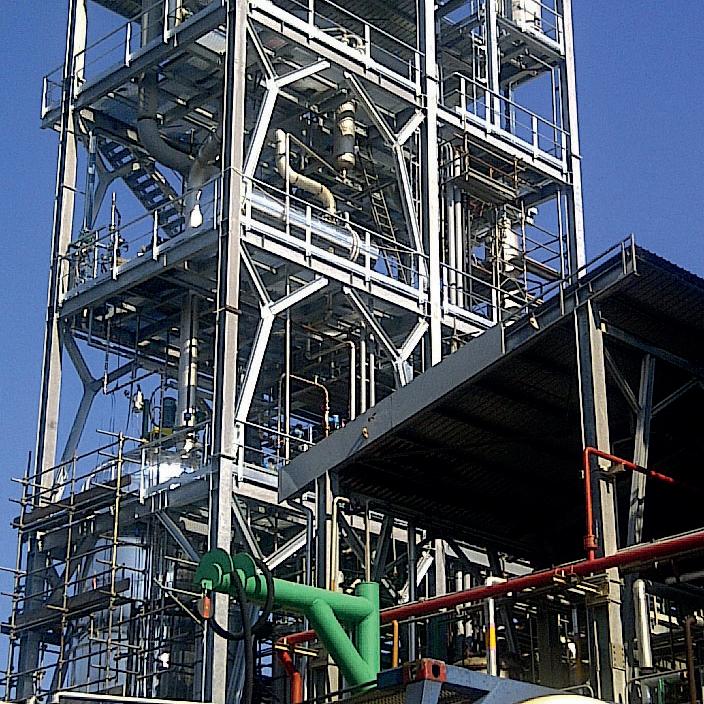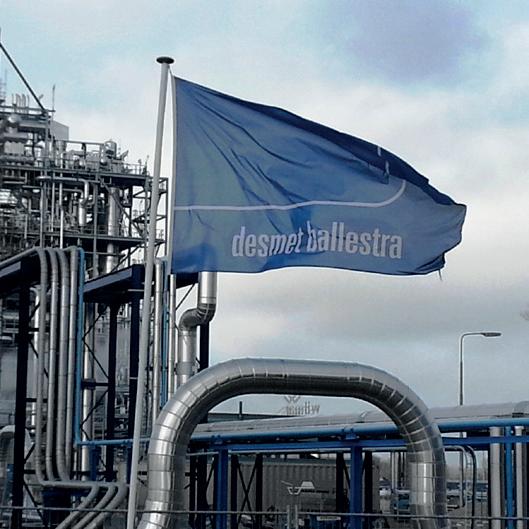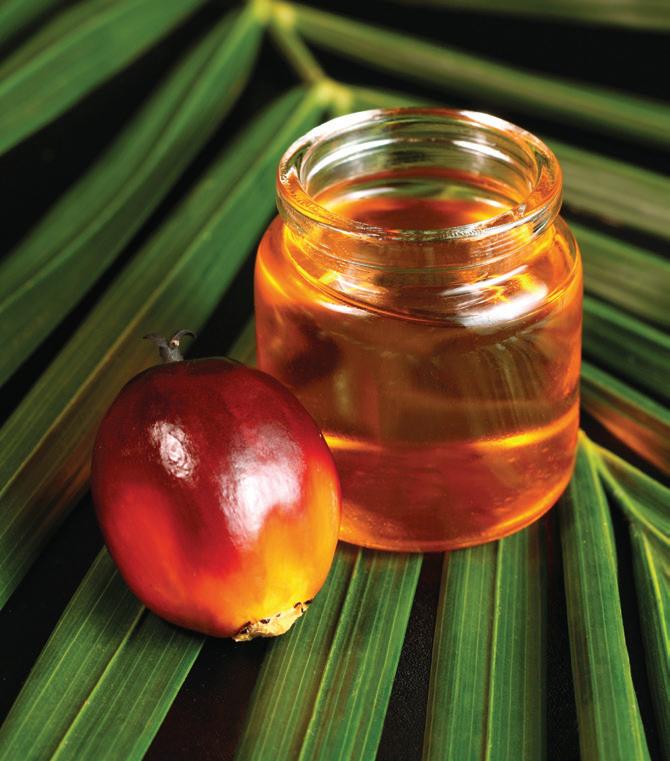
11 minute read
Moving downstream
Moving downstream Oils & Fats Conference – London, England 7
There is a wide range of choices for palm oil operators wishing to move downstream into oleochemical derivatives. What are the most promising products, their applications and the production processes involved? Thomas Blocher
The move downstream from basic oleochemicals (oils, fatty acids and glycerine) to derivatives can seem quite alluring. It seems as if almost everyone is doing it these days, either through acquisitions or internal development.
Moving into derivatives can lead to new customers, the capturing of additional revenue from existing customers and higher utilisation of raw materials. However, as with any important decision, especially one that impacts on a company’s strategic focus, the
ramifications of the decision should be thoroughly investigated to avoid, or properly plan for, possible risks.
Myriad choices There are myriad choices when it comes to oleochemical derivatives and deciding which to produce can be challenging. An obvious first step might be to move into downstream commodities such as detergent alcohols – these technologies are usually well known and the transition to the new technology may not be such a big leap. The market size is easier to estimate and supply chains can be a little more transparent.
But what will your competitive advantage be that will lead customers to buy from you? Higher product quality, lower costs (perhaps due to a more advanced technology) or perhaps superior technical service? Perhaps you can fill demand by being the only manufacturer in your country or region.
Moving into specialities is also an option. These include pharmaceutical actives and speciality ingredients for cosmetics, among others. The sales of specialities often yield higher margins. But while specialities can command higher prices, they can often require a higher level of technology, application experience, safety requirements and new raw materials.
Commodities and specialities both have their advantages and disadvantages and moving downstream at all carries risks. With this in mind, Buss ChemTech has developed a simplified road map of oleochemical derivatives including some of the products that can be made from palm fatty acids and their related technologies (see diagram above).
u Ethoxylates Ethoxylates are non-ionic surfactants with applications in numerous markets including personal care, biotechnology, pharmaceuticals, oil-well, food, agriculture, textiles and coatings.
They can be used as detergents (in laundry and surface cleaners); emulsifiers (in emulsions, creams and ointments); wetting agents (for adhesives, paints and coatings and electroplating processes); dispersants (for pigments and crop protection and other biocides); stabilisers (emulsion polymers) and as corrosion
Options to purify feedstock } Acid Degumming } Fatty Acid Stripping } Nano Neutralisation
Options to utilize high FFA feedstocks } Acid Esterifi cation } Glycerolysis } Esterifi ed Product Neutralization
Biodiesel Plant } Oil Drying } Transesterifi cation } Glycerine Separation } Methyl Ester Washing } Methyl Ester Drying } Glycerine Purifi cation } Glycerine Concentration } Methanol Rectification
Options to further enhance biodiesel quality } Methyl Ester Prewashing } Methyl Ester Clarifi cation } Methyl Ester Distillation
Option to further enhance glycerine quality } Glycerine Distillation
OLEOCHEMICALS
Fatty Acid Processing Plant } Fat Splitting } Fatty Acid Distillation } Fatty Acid Fractional Distillation } Fatty acid Hydrogenation } Fatty Acid Dry Fractionation } Sweetwater Treatment } Sweetwater Concentration } Glycerine Distillation
Fatty Alcohols (Johnson Matthey Davy Technologies) } Fatty Acids Esterifi cation } Methyl Ester Hydrogenation } Fatty Alcohol Refi ning } Fatty Alcohol Post Hydrogenation } Fatty Alcohol Fractional Distillation
Fatty Acids Methyl Ester Process Plants } Methyl Ester Fractional Distillation } Methyl Ester Hydrogenation





In more than 40 years, Desmet Ballestra has installed over 400 oleochemical and biodiesel plants worldwide
Oleochemicals & Biodiesel
The advantages of palm fatty acids

Palm oil serves as an important feedstock for oleochemicals, with Malaysia and Indonesia being the dominant producers of fatty acids and fatty alcohols in Southeast Asia.
Palm oil chiefly comprises palmitic acid C16 (44–45%) and oleic acid, C18:1 (39–40%), along with linoleic acid, C18:2 (10–11%) and a trace amount of linolenic acid, C18:3. Palm kernel oil (PKO) is characterised by its high level of shorter and medium fatty acid chain lengths (mostly C12 and C14).
Over two thirds of oleochemicals derivatives are used in the manufacture of surfactants. With its ‘two for one’ nature, oil palm is a flexible feedstock for a variety of products that provides something for practically everyone: the longer fatty-acid chains preferred for liquid detergents or the shorter chains required by surface cleaners.
And unique in oleochemicals as compared to petrochemicals, the various sources of fatty-acids are often interchangeable. With the highest productivity of all crops, oil palm - if suitably (sustainably) managed - makes for one of the most efficient sources of feedstock for surfactants, one of the most important segments in the chemical industry.
inhibitors (in metal working fluids).
Typical oleochemical compounds that are ethoxylated are fatty acids, alcohols, amines, polyglycerol esters, triglycerides and sorbitan esters.
The sterotypical ethoxylation process involves treating a fatty alcohol with ethylene oxide (EO) and potassium hydroxyide (KOH) which serves as a catalyst. The reactor is pressurised with nitrogen and heated to about 150°C. Typically 2-9 units of EO are added to each alcohol for commodity surfactant or surfactant intermediates. For specialities, other starters can be used and the units of EO added can reach as high as 100. A wide range of products are obtained as a result. The degree of ethoxylation generally determines the surfactant properties. u
Narrow range ethoxylates With conventional catalysts such as KOH and sodium hydroxide (NaOH), a distribution of ethoxymers is obtained. For example, if a 9-mole ethoxylate is targeted using a conventional catalyst, a broad range of ethoxylates will result, with the degree of ethoxylation being anywhere from three to 30 moles of EO. A much tighter distribution can be obtained with narrow range catalysts. Narrow range surfactants can be incorporated into alkyl ether sulfates or mixed with other anionic surfactants
and exhibit beneficial properties such as reduced irritation to skin/eyes and lower free alcohol content.
The catalyst and its method of addition are the key to achieving these narrow range compounds. The catalyst is typically a so-called ‘double metal cyanide’ type - a di-metal compound with a cyano group.
Methyl ester ethoxylates (MEE) This special narrow range ethoxylate was seen as a potential low-cost replacement for higher cost fatty alcohol feedstocks. However, the market has not quite lived up to its promise yet. As with other narrow range ethoxylates, the catalyst plays a significant role, including how and when it is dosed. Original players in this area from 1990 were Henkel, Vista and Lion. Today, several others, including some large names in the chemical industry, also have the technology but none is as yet known to license the technology.
EHS considerations Ethoxylation poses some challenges the potential producer will need to consider: sourcing EO, the flammability of EO and the regulation of regulated by-products. The challenges of sourcing EO are well reported. Naturally, free capacity must be found in the quantity and location desired. Finding capacity should become easier with new crackers coming on line. However, the shipment of EO is highly regulated so unless your desired location is near an EO source, you may find significant challenges. Not only are new truck and rail routes rarely approved, even requests from new clients on existing routes are often rejected. Thus, potential producers must be prepared to consider locating their plant near an EO source. EO is extremely flammable and its mixtures with air are explosive. When heated, it may rapidly expand, causing fire and explosion. EO in the presence of water can hydrolyse to ethylene glycol and form polyethylene oxide, which is eventually oxidised by air and leads to hotspots that can trigger to explosive decomposition. Each major technology supplier has its own safety procedures including nitrogen blanketing and designing equipment to withstand an explosion.
As a byproduct of the ethoxylation process, dioxane can contaminate cosmetics and personal care products such as deodorants, shampoos, toothpastes and mouthwashes. It is irritating to the eyes and respiratory tract and exposure may cause damage to the central nervous system, liver and kidneys. And since dioxane is highly soluble in water, it does not readily bind to soils but readily leaches to groundwater. It is also resistant to naturally-occurring biodegradation processes. Due to these properties, a dioxane plume is often much larger than the associated solvent plume. Stripping and other methods are used to reduce the amount of dioxane to acceptable levels.
Fatty amines Another class of oleochemical derivatives are fatty amines and the chemical products derived from them. They are used in many industries including cosmetics, mining, agriculture and pharmaceuticals. Fatty amines can be subclassified as nitriles; primary, secondary and tertiary amines; diamines; and quaternary ammonium salts. These last can maintain the properties of the underlying amine but increase the water solubility. Amine salts are useful as flotation agents, corrosion inhibitors and lubricants. The single largest market use for quaternary fatty amines is in fabric softeners. Another significant use for dialkyldimethyl quaternary ammonium salts and alkylbenzyldimethylammonium salts is in preparing organoclays for use as drilling muds, paint thickeners and lubricants. Betaines or speciality quaternaries, are used in the personal care industry in shampoos, conditioners, foaming and wetting agents.
Important uses for diamines include products for corrosion inhibitors, gasoline and fuel oil additives, flotation agents, pigment wetting agents, epoxy curing agents, herbicides, and asphalt emulsifiers. Fatty amines and derivatives are widely used in the oil field. In the mining industry, amines and diamines are used in the recovery and purification of minerals. A major use of fatty diamines is as asphalt emulsifiers. Diamines have also been used as epoxy curing agents, corrosion inhibitors, gasoline and fuel oil additives, and pigment wetting agents. A major use for ethoxylated and propoxylated amines is as an anti-static agent in the textile and plastics industries. Examples of uses for amine oxides include detergents, personal care, as a foam booster and stabiliser, or as a dispersant for glass fibres.
Amine production Fatty amines are commonly prepared from fatty acids. The overall reaction is sometimes referred to as the nitrile process and begins with a reaction between the fatty acid and ammonia at high temperatures (>250°C) and in the presence of a metal oxide catalyst (such as alumina or zinc oxide) to give the fatty nitrile. The fatty amine is obtained from this by hydrogenation with any of a number of reagents, and typically a Raney nickel, cobalt or copper chromite catalysts. When conducted in the presence of excess ammonia, the hydrogenation results in primary amines. In the absence of ammonia, secondary and tertiary amines are produced. Alternatively, tertiary fatty amines can be generated directly from the reaction of fatty alcohols with alkylamines. The tertiary amines are precursors to quaternary ammonium salts. More recent developments include continuous hydrogenation, although the process can be a little trickier and the catalyst concentration often needs to be altered. However, there are advantages in terms of equipment size (with a smaller reactor), consumption (less catalyst and energy consumption) and consistent product quality. A combination of a high performance reactor and highly active catalyst can also achieve low iodine values during hydrogenation, in continuous as well as batch modes. And chrome-free catalysts for tertiary amine production are beginning to come onto the market in response to the tightening regulations of Chrome VI.
to consider are the acyl or fatty acid (FA) chlorides. These are used in a few markets such as surfactants, pharmaceuticals and crop protection. The importance of acid chlorides in preparative work is well known to chemists. Stearoyl chloride, for example, has many uses, among them the preparation of substituted imides, amides and acid anhydrides, the esterification of alcohols and the synthesis of organic compounds.
An older method to produce fatty acid chlorides is to react dry hydrogen chloride with isopropenyl stearate in solution or in the molten state to form high purity stearoyl chloride. The acid chloride is formed by the displacement of acetone from the isopropenyl stearate.
A more recently developed route commercialised in the past decade is the chlorination of the fatty acid through a reaction with phosgene. This colourless gas is very toxic but it is a valuable industrial reagent and building block in synthesis of pharmaceuticals and other organic compounds.
Due to the obvious safety concerns, phosgene is often produced and consumed within the same plant. Thus, companies considering the production of fatty acid chlorides should either have access to phosgene via pipeline or be prepared to produce phosgene themselves. Industrially, phosgene is produced by passing purified carbon monoxide and chlorine gas through a bed of porous activated carbon, which serves as a catalyst. The reaction is exothermic so the reactor must be cooled. Typically, the reaction is conducted between 50- 150°C. Besides the obvious need for robust safety systems and
sound reactor design, tight process control is also required to ensure acceptable catalyst life, reactor integrity and good, consistent product quality over the life of the unit.
State-of-the-art phosgene generators include features like secondary reactor containment, on-line product monitoring and separate process and safety control systems. A robust safety concept allows chemical companies to produce this versatile reagent and the downstream derivatives like fatty acid chlorides with peace of mind.
Conclusion The move downstream into oleochemicals derivatives can offer new markets, customers and additional revenue but also carries risks. Whether it be commodity or speciality derivatives, any move needs to be properly explored and the advantages and risks weighed up. The best choice usually leverages existing expertise, access to raw materials and current customer base. Your technology partner can assist you in evaluating your choices.
Thomas Blocher is the global business manager of reaction technology at Buss ChemTech, Switzerland











